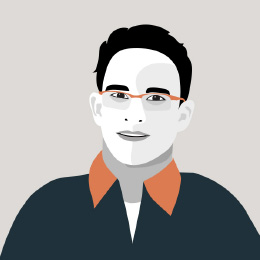This year, the focus is on heroes of design, thinking and innovation. People who made us think, behave and see the world differently. In this first edition, we’re showcasing two great communicators.
We’ve selected one great ad man and one inspiring designer. David Ogilvy, the father of modern advertising, has to be top of the list for his influence on the world of advertising. From the world of graphic design, we have Alan Fletcher whose amazing work spans the last 60 years.
David Ogilvy
David Ogilvy led an unconventional life, which certainly can’t be captured in a few sentences. Hailing from a notable Scottish family, he started school in Edinburgh, from where he was accepted into Oxford University but left in 1931 when his family fell on hard times. He then headed to Paris to become an apprentice chef, and after a year, became a door-to-door salesman for AGA stoves. On the strength of a sales manual he wrote for AGA, he landed a job at a London advertising agency, from where he went to George Gallup’s Audience Research Institute in New York.
During WWII, he worked for the British Intelligence Service (learning the power of propaganda). When the war was over, he went to live with an Amish community before returning to Manhatten to set up Ogilvy, Benson & Mather, where he stuck to his belief “that successful product advertising is based on information about its consumers”. He went on to sell soap (Dove), countries (Puerto Rico) and cars (Mercedes-Benz). For Mercedes, he increased sales 4 times (in just one year) from 10,000 to 40,000 cars, when the brand wasn’t popular in the U.S.
Read more: David Ogilvy
Alan Fletcher
Alan Fletcher was one of the most highly regarded and prolific graphic designers of his generation. He was born in Nairobi, the son of a civil servant. When his father became ill, he returned to London and immersed himself in the blossoming creative scene. His friends included Peter Blake, Terrence Conran and Len Deighton in London, and Paul Rand, Bob Gill and Saul Bass from his studies in the US.
In 1962, he founded a design firm called ‘Fletcher/Forbes/Gill’ with Colin Forbes & Bob Gill. The company later evolved into ‘Pentagram’ and their clients included Lloyd’s of London, Daimler Benz and Reuters.
Probably his most profound legacy was the co-founding (along with David Bailey and Terence Donovan) of the Designers and Art Directors Association (D&AD) in 1962. The D&AD Awards have become the most prestigious industry award for the Advertising & Design industry. For many, being awarded the ‘Little Yellow Pencil’ is the pinnacle of creative achievement.
Read more: Alan Fletcher: The Man Who Taught People How to Look
Here are three insights which seem to sum up David Ogilvy’s philosophy for advertising. 1. Do your homework. David Ogilvy spent three weeks finding out about Rolls Royce and its customers before he started any creative work. And it still holds true today: know your product, know what you’re selling and who’s buying it. 2. Put your energy into the headline. David Ogilvy: “On average, five times as many people read the headline as read the body copy. When you have written your headline, you have spent eighty cents out of your dollar. If you haven’t done some selling in your headline, you have wasted 80 percent of your client’s money.” 3. Never talk down to a customer. In his words: “A consumer is not a moron, she is your wife.” This goes back to his days at Gallup: when there is doubt over the effectiveness of an ad, the best thing is to talk to the customer and understand what he/she thinks. One of David Ogilvy’s most famous headlines: “At 60 miles an hour the loudest noise in this new Rolls-Royce comes from the electric clock”. See more: https://www.youtube.com/watch?v=VsLv2-odaUA Share this article [addthis tool="addthis_inline_share_toolbox"]


